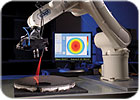
The scanning software has the capability to automatically find and measure holes on the surface using image processing. Source: NASA Ames Research Center
With the help of a commercial robot arm-Adept Viper 850 and NASA’s 3-D scanning technology, the engineers at the NASA Ames Research Center (Mountain View, CA) 3-D vision lab have created a large area robot scanner. This new robotic high-speed 3-D scanner was developed to demonstrate the capability of inspecting an entire assembled CEV heat shield and its individual components. The 3-D scanner technology was originally developed for the handheld mold impression laser tool (MILT) to inspect space shuttle tiles, and be used on planetary rovers to aid navigation.
Automatic Scanning
The large heat shield samples are hemisphere shaped and used on NASA spacecraft for protection on re-entry into the atmosphere. The engineers have put a patented NASA laser scanner on the six-axis robot arm. The new robotic scanner uses NASA’s 3-D scanning software technology to scan the shields as the robot moves across the surface. As it scans, it develops a 3-D model of the shield from laser surface reflections. The proof of concept project uses the 3-D model information to look for cracks, faults or holes and to see if the shield is the correct shape. Using the Adept Viper robot allows the engineers to automatically scan larger areas more efficiently than attempting to scan the shields by hand or with 3-D scanners with limited area coverage.The laser scanner uses laser triangulation to measure the 3-D locations at different points as it is scanning. While it scans it sends the 3-D information over to a control computer. The scanner also sends a digital pulse to the robot every third scan frame at 214 hertz. The robot uses the latching functionality with Adept’s V+ programming language in combination with the digital pulses from the scanner to store positions corresponding to every third scanner frame. The control computer matches the stored positions from the robot with the scanner frames and interpolates between missing positions to create the 3-D image of the shield.
High-Speed
The scanning software has the capability to automatically find and measure holes on the surface using image processing on the 3-D image. Handheld MILT scanners are useful to measure holes in smaller tiles like those used on space shuttle tiles, but a robot is more effective and efficient for a large heat shield. The scan information for large heat shields is used to create a large 3-D model. Similar technology could be used on other large surfaces such as an airplane if the robot was big enough.The exceptional speed and resolution of the robotic Ames high-speed 3-D scanner enables the engineers to scan an entire heat shield at high resolution in a couple of hours rather than days.
Software for controlling the robot, displaying and patching 3-D scans in real time, zooming into and measuring defect dimensions, and providing recession and other kinds of analysis have been developed or adapted from the MILT project.
Adept Technology Inc.
(925) 245-3400
www.adept.com